Reflective Essay on Person-Centered Care: Ms. XYZ's Hospital Journey
VerifiedAdded on 2020/05/16
|10
|2929
|287
Essay
AI Summary
This essay delves into the application of person-centered care (PCC) through a reflective analysis of a 78-year-old female patient, Ms. XYZ, admitted to the hospital with NSTEMI myocardial infarction and a history of related conditions. The essay examines the PCC principles, including patient and family involvement in care planning, communication, respect for values and preferences, and emotional support. It evaluates the care provided to Ms. XYZ, highlighting instances where healthcare professionals adhered to PCC standards, such as effective communication, maintaining patient dignity, and involving family members in decision-making. The essay also reflects on the importance of patient education, addressing anxiety, and ensuring physical comfort. It references relevant standards and codes of conduct from the Nursing and Midwifery Board of Australia (NMBA) and the Australian College of Nursing (ACN), concluding that adherence to PCC principles contributes to positive health outcomes and patient satisfaction. The essay underscores the significance of continuity of care, discharge planning, and family support in providing holistic patient care.
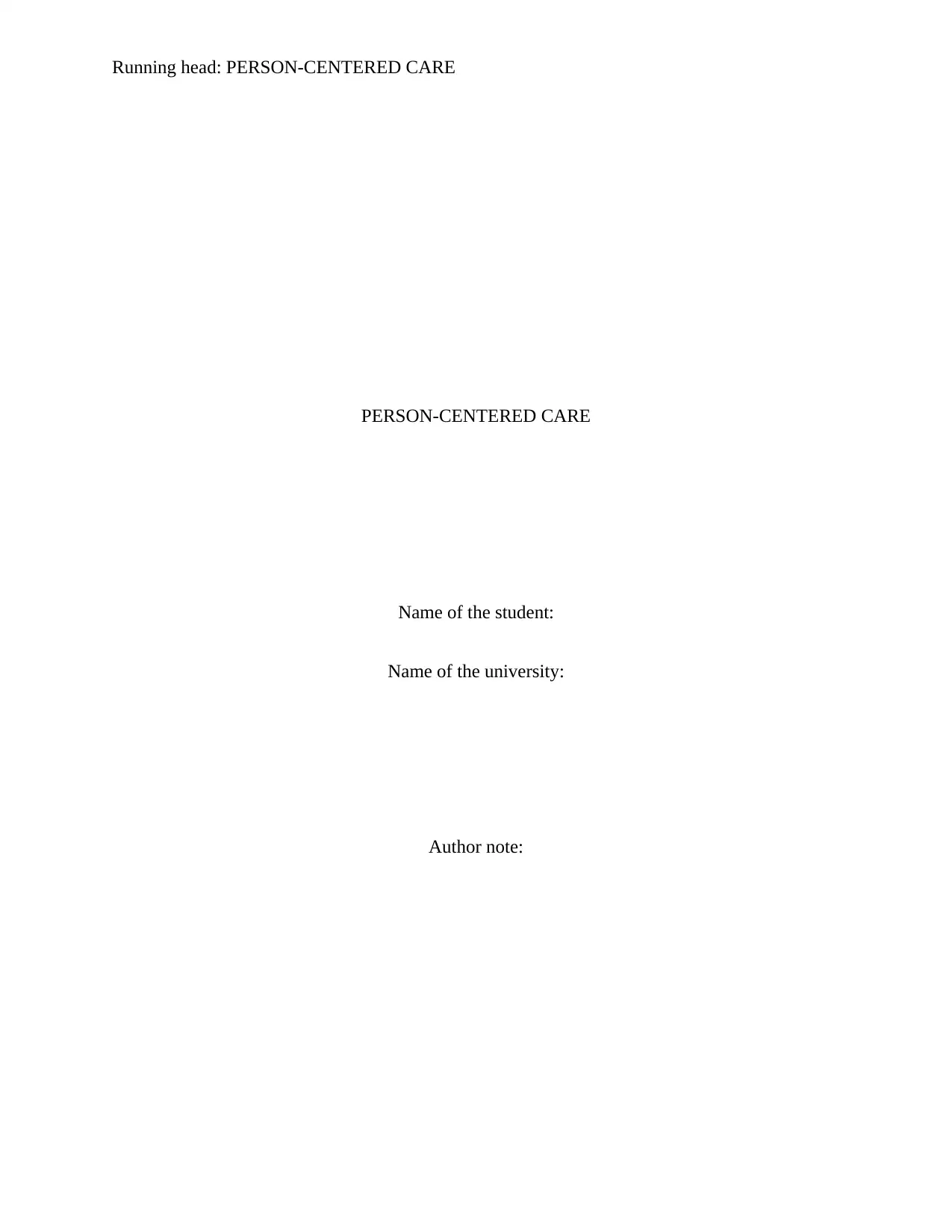
Running head: PERSON-CENTERED CARE
PERSON-CENTERED CARE
Name of the student:
Name of the university:
Author note:
PERSON-CENTERED CARE
Name of the student:
Name of the university:
Author note:
Paraphrase This Document
Need a fresh take? Get an instant paraphrase of this document with our AI Paraphraser
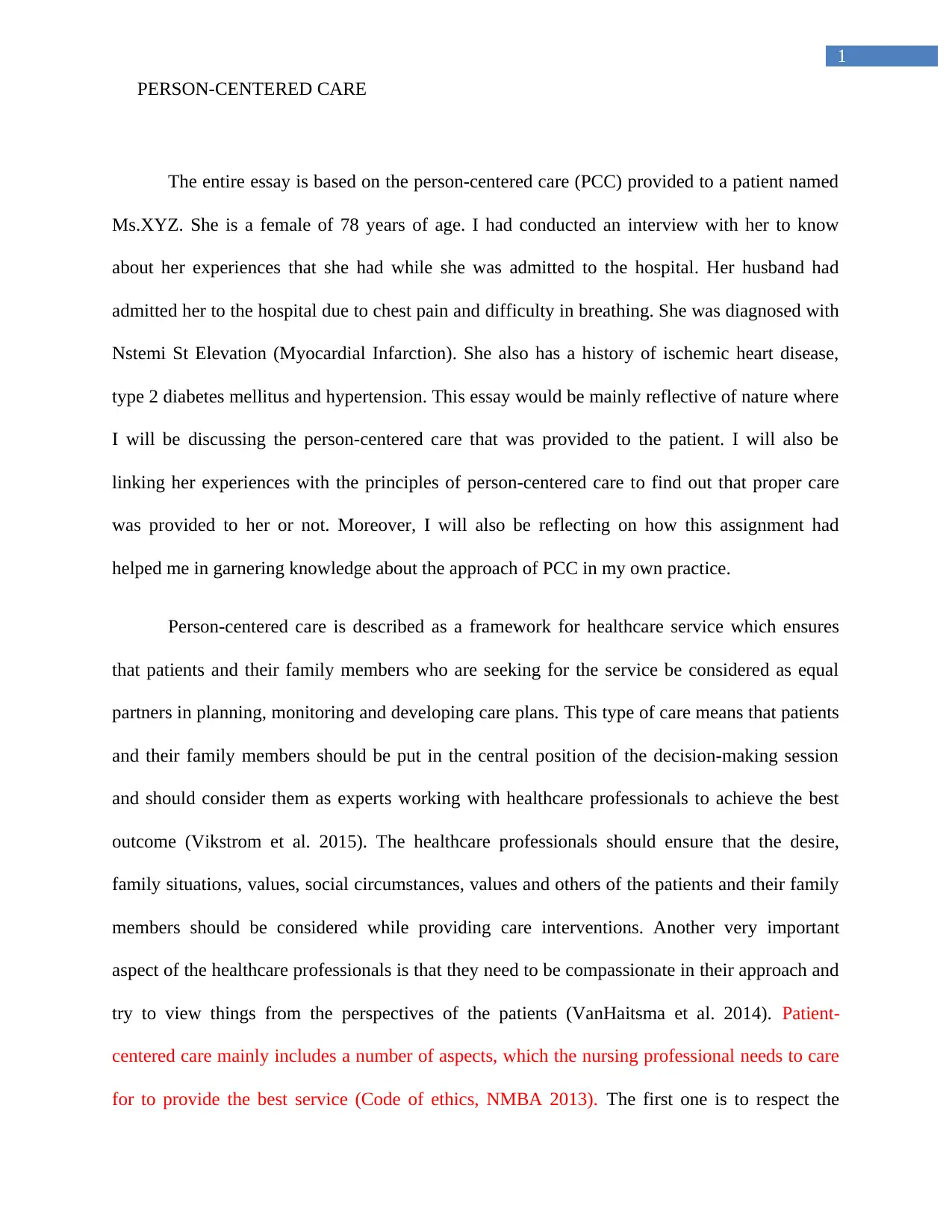
1
PERSON-CENTERED CARE
The entire essay is based on the person-centered care (PCC) provided to a patient named
Ms.XYZ. She is a female of 78 years of age. I had conducted an interview with her to know
about her experiences that she had while she was admitted to the hospital. Her husband had
admitted her to the hospital due to chest pain and difficulty in breathing. She was diagnosed with
Nstemi St Elevation (Myocardial Infarction). She also has a history of ischemic heart disease,
type 2 diabetes mellitus and hypertension. This essay would be mainly reflective of nature where
I will be discussing the person-centered care that was provided to the patient. I will also be
linking her experiences with the principles of person-centered care to find out that proper care
was provided to her or not. Moreover, I will also be reflecting on how this assignment had
helped me in garnering knowledge about the approach of PCC in my own practice.
Person-centered care is described as a framework for healthcare service which ensures
that patients and their family members who are seeking for the service be considered as equal
partners in planning, monitoring and developing care plans. This type of care means that patients
and their family members should be put in the central position of the decision-making session
and should consider them as experts working with healthcare professionals to achieve the best
outcome (Vikstrom et al. 2015). The healthcare professionals should ensure that the desire,
family situations, values, social circumstances, values and others of the patients and their family
members should be considered while providing care interventions. Another very important
aspect of the healthcare professionals is that they need to be compassionate in their approach and
try to view things from the perspectives of the patients (VanHaitsma et al. 2014). Patient-
centered care mainly includes a number of aspects, which the nursing professional needs to care
for to provide the best service (Code of ethics, NMBA 2013). The first one is to respect the
PERSON-CENTERED CARE
The entire essay is based on the person-centered care (PCC) provided to a patient named
Ms.XYZ. She is a female of 78 years of age. I had conducted an interview with her to know
about her experiences that she had while she was admitted to the hospital. Her husband had
admitted her to the hospital due to chest pain and difficulty in breathing. She was diagnosed with
Nstemi St Elevation (Myocardial Infarction). She also has a history of ischemic heart disease,
type 2 diabetes mellitus and hypertension. This essay would be mainly reflective of nature where
I will be discussing the person-centered care that was provided to the patient. I will also be
linking her experiences with the principles of person-centered care to find out that proper care
was provided to her or not. Moreover, I will also be reflecting on how this assignment had
helped me in garnering knowledge about the approach of PCC in my own practice.
Person-centered care is described as a framework for healthcare service which ensures
that patients and their family members who are seeking for the service be considered as equal
partners in planning, monitoring and developing care plans. This type of care means that patients
and their family members should be put in the central position of the decision-making session
and should consider them as experts working with healthcare professionals to achieve the best
outcome (Vikstrom et al. 2015). The healthcare professionals should ensure that the desire,
family situations, values, social circumstances, values and others of the patients and their family
members should be considered while providing care interventions. Another very important
aspect of the healthcare professionals is that they need to be compassionate in their approach and
try to view things from the perspectives of the patients (VanHaitsma et al. 2014). Patient-
centered care mainly includes a number of aspects, which the nursing professional needs to care
for to provide the best service (Code of ethics, NMBA 2013). The first one is to respect the
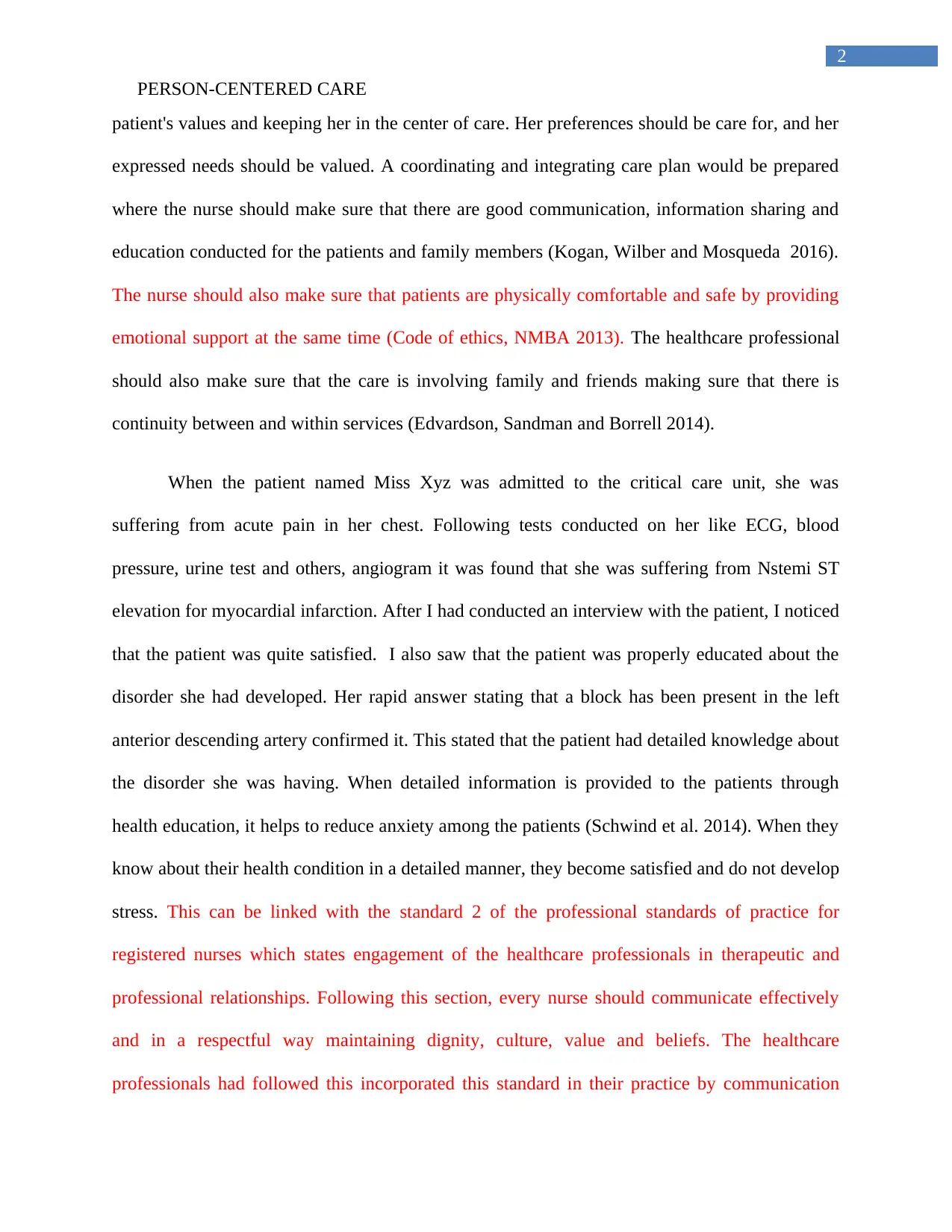
2
PERSON-CENTERED CARE
patient's values and keeping her in the center of care. Her preferences should be care for, and her
expressed needs should be valued. A coordinating and integrating care plan would be prepared
where the nurse should make sure that there are good communication, information sharing and
education conducted for the patients and family members (Kogan, Wilber and Mosqueda 2016).
The nurse should also make sure that patients are physically comfortable and safe by providing
emotional support at the same time (Code of ethics, NMBA 2013). The healthcare professional
should also make sure that the care is involving family and friends making sure that there is
continuity between and within services (Edvardson, Sandman and Borrell 2014).
When the patient named Miss Xyz was admitted to the critical care unit, she was
suffering from acute pain in her chest. Following tests conducted on her like ECG, blood
pressure, urine test and others, angiogram it was found that she was suffering from Nstemi ST
elevation for myocardial infarction. After I had conducted an interview with the patient, I noticed
that the patient was quite satisfied. I also saw that the patient was properly educated about the
disorder she had developed. Her rapid answer stating that a block has been present in the left
anterior descending artery confirmed it. This stated that the patient had detailed knowledge about
the disorder she was having. When detailed information is provided to the patients through
health education, it helps to reduce anxiety among the patients (Schwind et al. 2014). When they
know about their health condition in a detailed manner, they become satisfied and do not develop
stress. This can be linked with the standard 2 of the professional standards of practice for
registered nurses which states engagement of the healthcare professionals in therapeutic and
professional relationships. Following this section, every nurse should communicate effectively
and in a respectful way maintaining dignity, culture, value and beliefs. The healthcare
professionals had followed this incorporated this standard in their practice by communication
PERSON-CENTERED CARE
patient's values and keeping her in the center of care. Her preferences should be care for, and her
expressed needs should be valued. A coordinating and integrating care plan would be prepared
where the nurse should make sure that there are good communication, information sharing and
education conducted for the patients and family members (Kogan, Wilber and Mosqueda 2016).
The nurse should also make sure that patients are physically comfortable and safe by providing
emotional support at the same time (Code of ethics, NMBA 2013). The healthcare professional
should also make sure that the care is involving family and friends making sure that there is
continuity between and within services (Edvardson, Sandman and Borrell 2014).
When the patient named Miss Xyz was admitted to the critical care unit, she was
suffering from acute pain in her chest. Following tests conducted on her like ECG, blood
pressure, urine test and others, angiogram it was found that she was suffering from Nstemi ST
elevation for myocardial infarction. After I had conducted an interview with the patient, I noticed
that the patient was quite satisfied. I also saw that the patient was properly educated about the
disorder she had developed. Her rapid answer stating that a block has been present in the left
anterior descending artery confirmed it. This stated that the patient had detailed knowledge about
the disorder she was having. When detailed information is provided to the patients through
health education, it helps to reduce anxiety among the patients (Schwind et al. 2014). When they
know about their health condition in a detailed manner, they become satisfied and do not develop
stress. This can be linked with the standard 2 of the professional standards of practice for
registered nurses which states engagement of the healthcare professionals in therapeutic and
professional relationships. Following this section, every nurse should communicate effectively
and in a respectful way maintaining dignity, culture, value and beliefs. The healthcare
professionals had followed this incorporated this standard in their practice by communication
⊘ This is a preview!⊘
Do you want full access?
Subscribe today to unlock all pages.

Trusted by 1+ million students worldwide
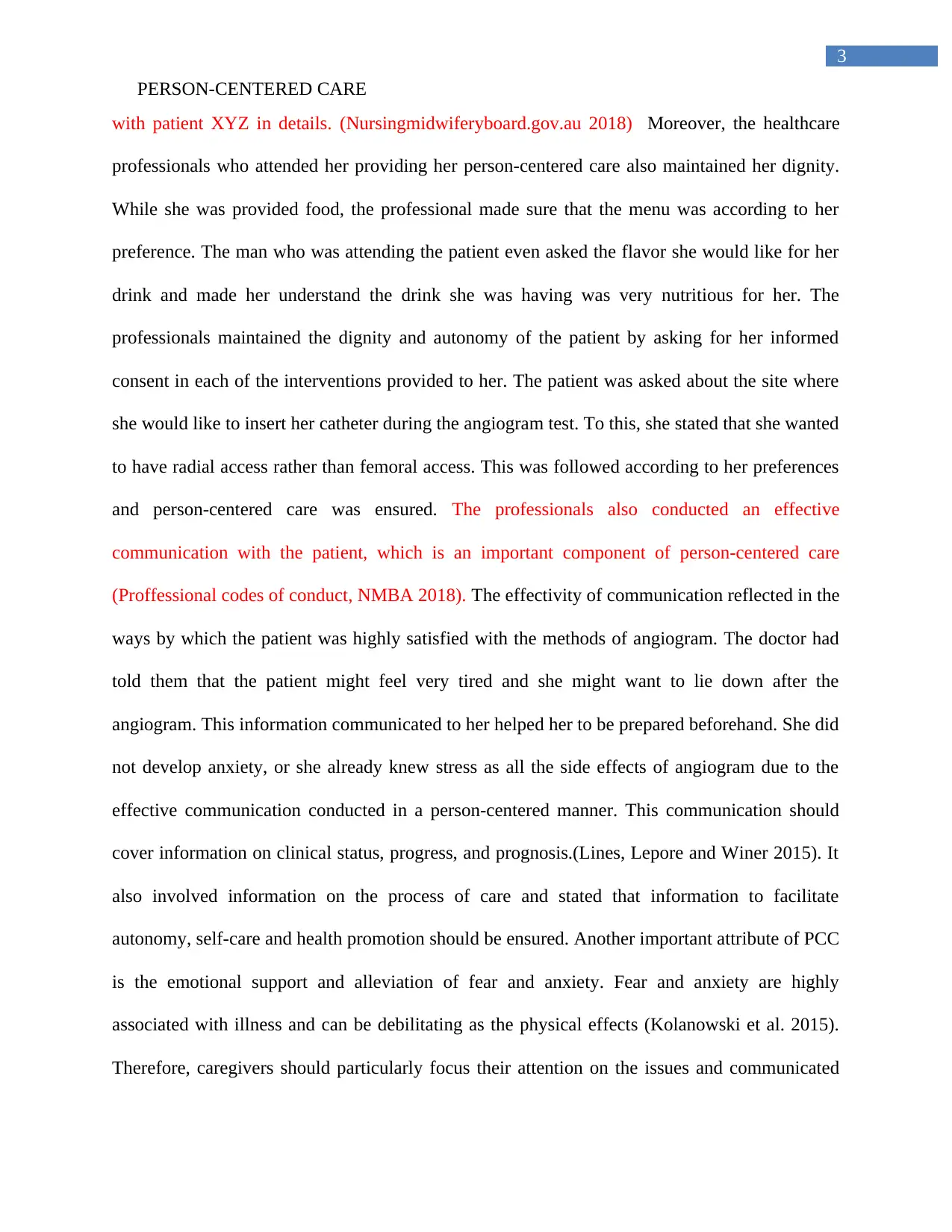
3
PERSON-CENTERED CARE
with patient XYZ in details. (Nursingmidwiferyboard.gov.au 2018) Moreover, the healthcare
professionals who attended her providing her person-centered care also maintained her dignity.
While she was provided food, the professional made sure that the menu was according to her
preference. The man who was attending the patient even asked the flavor she would like for her
drink and made her understand the drink she was having was very nutritious for her. The
professionals maintained the dignity and autonomy of the patient by asking for her informed
consent in each of the interventions provided to her. The patient was asked about the site where
she would like to insert her catheter during the angiogram test. To this, she stated that she wanted
to have radial access rather than femoral access. This was followed according to her preferences
and person-centered care was ensured. The professionals also conducted an effective
communication with the patient, which is an important component of person-centered care
(Proffessional codes of conduct, NMBA 2018). The effectivity of communication reflected in the
ways by which the patient was highly satisfied with the methods of angiogram. The doctor had
told them that the patient might feel very tired and she might want to lie down after the
angiogram. This information communicated to her helped her to be prepared beforehand. She did
not develop anxiety, or she already knew stress as all the side effects of angiogram due to the
effective communication conducted in a person-centered manner. This communication should
cover information on clinical status, progress, and prognosis.(Lines, Lepore and Winer 2015). It
also involved information on the process of care and stated that information to facilitate
autonomy, self-care and health promotion should be ensured. Another important attribute of PCC
is the emotional support and alleviation of fear and anxiety. Fear and anxiety are highly
associated with illness and can be debilitating as the physical effects (Kolanowski et al. 2015).
Therefore, caregivers should particularly focus their attention on the issues and communicated
PERSON-CENTERED CARE
with patient XYZ in details. (Nursingmidwiferyboard.gov.au 2018) Moreover, the healthcare
professionals who attended her providing her person-centered care also maintained her dignity.
While she was provided food, the professional made sure that the menu was according to her
preference. The man who was attending the patient even asked the flavor she would like for her
drink and made her understand the drink she was having was very nutritious for her. The
professionals maintained the dignity and autonomy of the patient by asking for her informed
consent in each of the interventions provided to her. The patient was asked about the site where
she would like to insert her catheter during the angiogram test. To this, she stated that she wanted
to have radial access rather than femoral access. This was followed according to her preferences
and person-centered care was ensured. The professionals also conducted an effective
communication with the patient, which is an important component of person-centered care
(Proffessional codes of conduct, NMBA 2018). The effectivity of communication reflected in the
ways by which the patient was highly satisfied with the methods of angiogram. The doctor had
told them that the patient might feel very tired and she might want to lie down after the
angiogram. This information communicated to her helped her to be prepared beforehand. She did
not develop anxiety, or she already knew stress as all the side effects of angiogram due to the
effective communication conducted in a person-centered manner. This communication should
cover information on clinical status, progress, and prognosis.(Lines, Lepore and Winer 2015). It
also involved information on the process of care and stated that information to facilitate
autonomy, self-care and health promotion should be ensured. Another important attribute of PCC
is the emotional support and alleviation of fear and anxiety. Fear and anxiety are highly
associated with illness and can be debilitating as the physical effects (Kolanowski et al. 2015).
Therefore, caregivers should particularly focus their attention on the issues and communicated
Paraphrase This Document
Need a fresh take? Get an instant paraphrase of this document with our AI Paraphraser

4
PERSON-CENTERED CARE
clearly about the interventions to be taken is that fear and anxiety is not created among patients.
The patients may develop anxiety over her physical status, treatment as well as prognosis. They
should also provide attention to anxiety provided over the impact of the illness on themselves
and the family (Couloridges et al. 2016). Moreover, anxiety over the financial impact of illness
may also make the patient stressed. Therefore, caregivers should provide emotional support and
act as agents for alleviating fear and anxiety (Chaudhury et al. 2014). It was found that the
patient named XYZ was known for every steps and test that were conducted for her. The care
professionals maintained standard two of the NSQHS standards that suggest that to provide safe
care to patients, caregivers should partner with their consumers in service planning and designing
the care. This includes strategic service planning, quality improvement activities and helping
patients in decision-making (Safetyandquality.gov.au, 2011). The care professionals who
attended Ms. XYZ ensured all these.
I have understood that physical comfort is important for every care professionals to
incorporate into her interventions. The level of physical comfort of patients needs to be assured
by the caregivers in the person-centered care (Safetyandquality.gov.au. 2010). I noticed that the
patient was very happy with the comfort she had received as the caregivers ensured that all her
preferences were maintained and the principles of non-maleficence were followed while
providing care. Therefore, in my practices as well, I will try to ensure the physical comforts of
the patient. Another positive aspect of the care was the involvement of family and friends.
Involving family and friends helps to solve the curiosity of the family members and handle
stresses of the family members well (Safetyandquality.gov.au. 2012). More the family members
are aware of the condition of the patients, the lesser chances are there of them suffering from
anxiety, blaming professionals later or taking legal actions against the professionals. Therefore,
PERSON-CENTERED CARE
clearly about the interventions to be taken is that fear and anxiety is not created among patients.
The patients may develop anxiety over her physical status, treatment as well as prognosis. They
should also provide attention to anxiety provided over the impact of the illness on themselves
and the family (Couloridges et al. 2016). Moreover, anxiety over the financial impact of illness
may also make the patient stressed. Therefore, caregivers should provide emotional support and
act as agents for alleviating fear and anxiety (Chaudhury et al. 2014). It was found that the
patient named XYZ was known for every steps and test that were conducted for her. The care
professionals maintained standard two of the NSQHS standards that suggest that to provide safe
care to patients, caregivers should partner with their consumers in service planning and designing
the care. This includes strategic service planning, quality improvement activities and helping
patients in decision-making (Safetyandquality.gov.au, 2011). The care professionals who
attended Ms. XYZ ensured all these.
I have understood that physical comfort is important for every care professionals to
incorporate into her interventions. The level of physical comfort of patients needs to be assured
by the caregivers in the person-centered care (Safetyandquality.gov.au. 2010). I noticed that the
patient was very happy with the comfort she had received as the caregivers ensured that all her
preferences were maintained and the principles of non-maleficence were followed while
providing care. Therefore, in my practices as well, I will try to ensure the physical comforts of
the patient. Another positive aspect of the care was the involvement of family and friends.
Involving family and friends helps to solve the curiosity of the family members and handle
stresses of the family members well (Safetyandquality.gov.au. 2012). More the family members
are aware of the condition of the patients, the lesser chances are there of them suffering from
anxiety, blaming professionals later or taking legal actions against the professionals. Therefore,
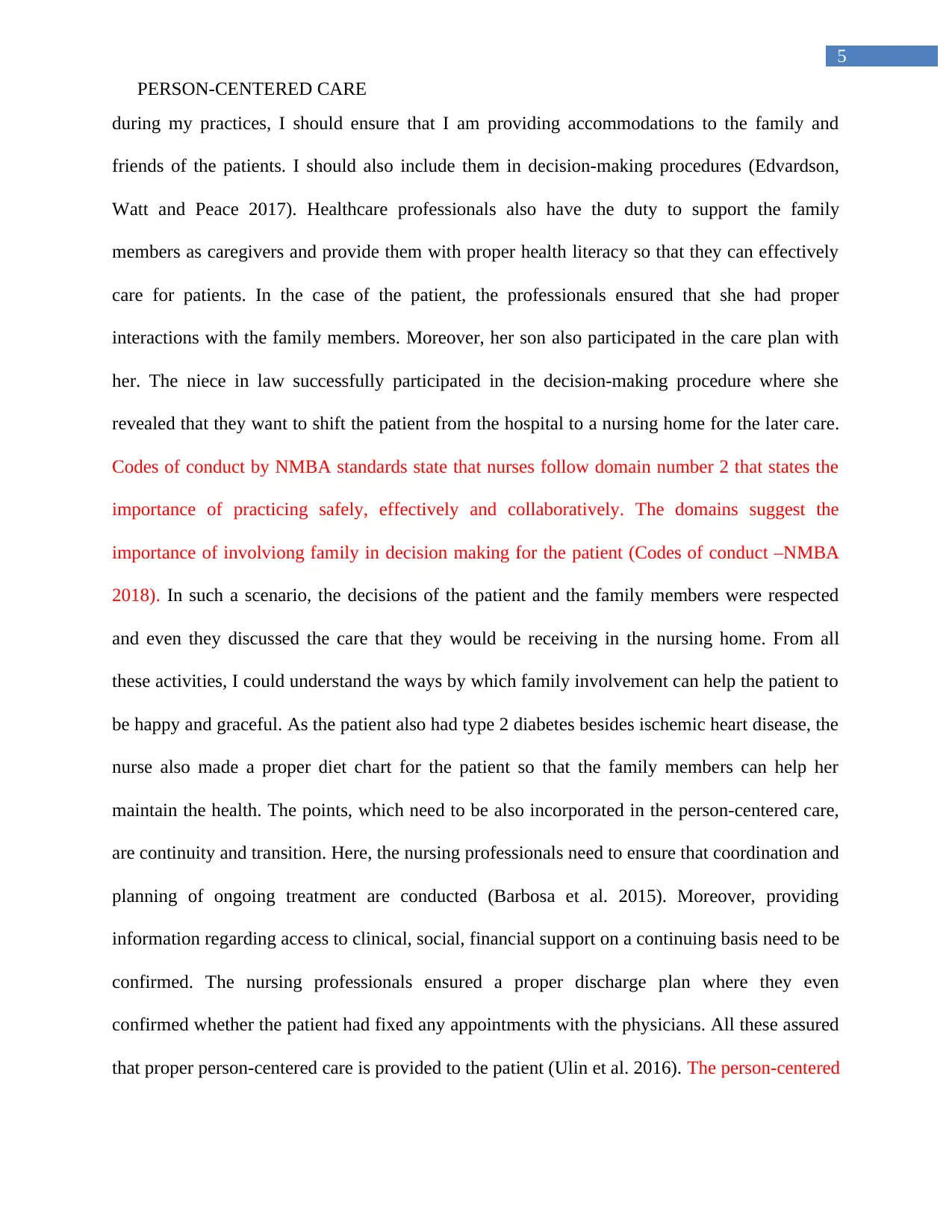
5
PERSON-CENTERED CARE
during my practices, I should ensure that I am providing accommodations to the family and
friends of the patients. I should also include them in decision-making procedures (Edvardson,
Watt and Peace 2017). Healthcare professionals also have the duty to support the family
members as caregivers and provide them with proper health literacy so that they can effectively
care for patients. In the case of the patient, the professionals ensured that she had proper
interactions with the family members. Moreover, her son also participated in the care plan with
her. The niece in law successfully participated in the decision-making procedure where she
revealed that they want to shift the patient from the hospital to a nursing home for the later care.
Codes of conduct by NMBA standards state that nurses follow domain number 2 that states the
importance of practicing safely, effectively and collaboratively. The domains suggest the
importance of involviong family in decision making for the patient (Codes of conduct –NMBA
2018). In such a scenario, the decisions of the patient and the family members were respected
and even they discussed the care that they would be receiving in the nursing home. From all
these activities, I could understand the ways by which family involvement can help the patient to
be happy and graceful. As the patient also had type 2 diabetes besides ischemic heart disease, the
nurse also made a proper diet chart for the patient so that the family members can help her
maintain the health. The points, which need to be also incorporated in the person-centered care,
are continuity and transition. Here, the nursing professionals need to ensure that coordination and
planning of ongoing treatment are conducted (Barbosa et al. 2015). Moreover, providing
information regarding access to clinical, social, financial support on a continuing basis need to be
confirmed. The nursing professionals ensured a proper discharge plan where they even
confirmed whether the patient had fixed any appointments with the physicians. All these assured
that proper person-centered care is provided to the patient (Ulin et al. 2016). The person-centered
PERSON-CENTERED CARE
during my practices, I should ensure that I am providing accommodations to the family and
friends of the patients. I should also include them in decision-making procedures (Edvardson,
Watt and Peace 2017). Healthcare professionals also have the duty to support the family
members as caregivers and provide them with proper health literacy so that they can effectively
care for patients. In the case of the patient, the professionals ensured that she had proper
interactions with the family members. Moreover, her son also participated in the care plan with
her. The niece in law successfully participated in the decision-making procedure where she
revealed that they want to shift the patient from the hospital to a nursing home for the later care.
Codes of conduct by NMBA standards state that nurses follow domain number 2 that states the
importance of practicing safely, effectively and collaboratively. The domains suggest the
importance of involviong family in decision making for the patient (Codes of conduct –NMBA
2018). In such a scenario, the decisions of the patient and the family members were respected
and even they discussed the care that they would be receiving in the nursing home. From all
these activities, I could understand the ways by which family involvement can help the patient to
be happy and graceful. As the patient also had type 2 diabetes besides ischemic heart disease, the
nurse also made a proper diet chart for the patient so that the family members can help her
maintain the health. The points, which need to be also incorporated in the person-centered care,
are continuity and transition. Here, the nursing professionals need to ensure that coordination and
planning of ongoing treatment are conducted (Barbosa et al. 2015). Moreover, providing
information regarding access to clinical, social, financial support on a continuing basis need to be
confirmed. The nursing professionals ensured a proper discharge plan where they even
confirmed whether the patient had fixed any appointments with the physicians. All these assured
that proper person-centered care is provided to the patient (Ulin et al. 2016). The person-centered
⊘ This is a preview!⊘
Do you want full access?
Subscribe today to unlock all pages.

Trusted by 1+ million students worldwide
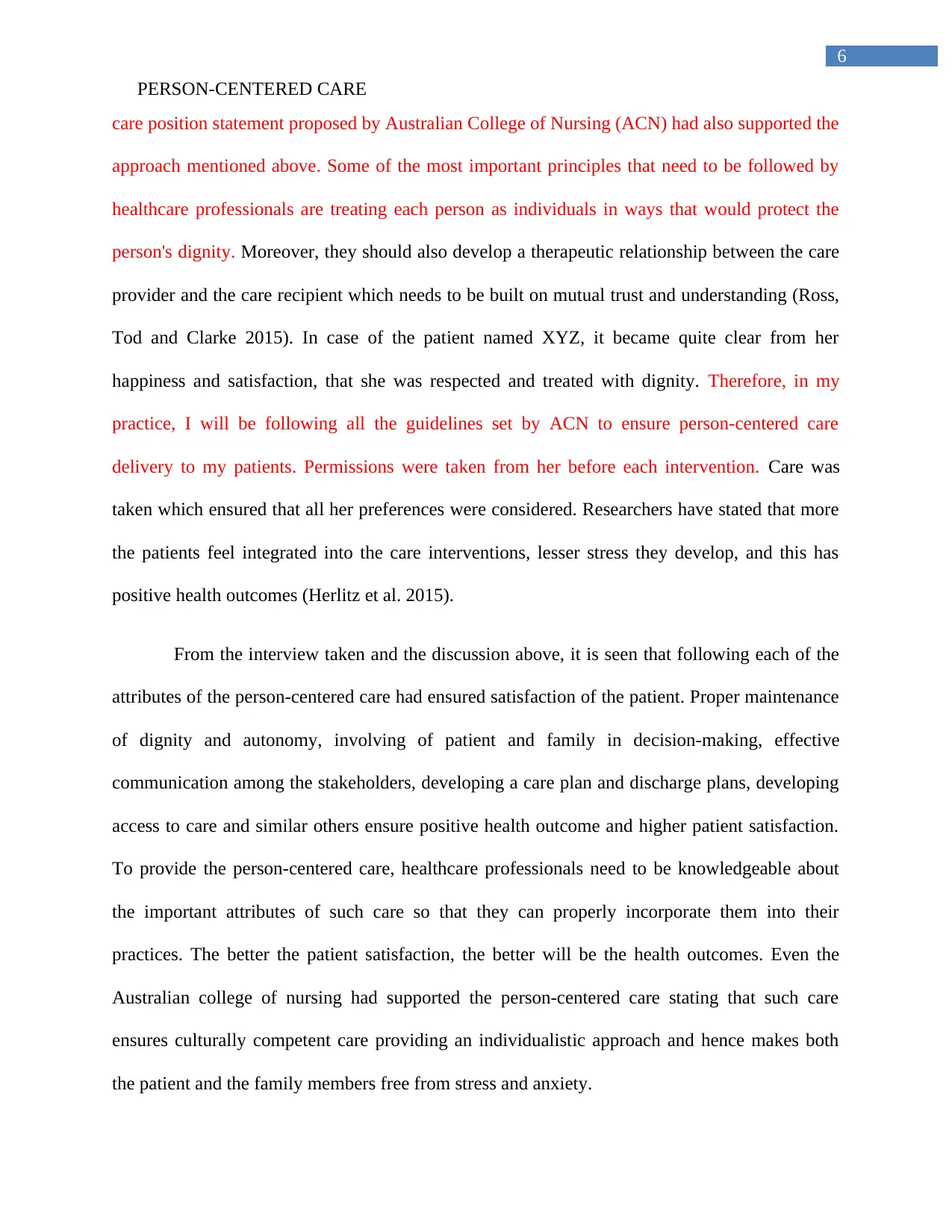
6
PERSON-CENTERED CARE
care position statement proposed by Australian College of Nursing (ACN) had also supported the
approach mentioned above. Some of the most important principles that need to be followed by
healthcare professionals are treating each person as individuals in ways that would protect the
person's dignity. Moreover, they should also develop a therapeutic relationship between the care
provider and the care recipient which needs to be built on mutual trust and understanding (Ross,
Tod and Clarke 2015). In case of the patient named XYZ, it became quite clear from her
happiness and satisfaction, that she was respected and treated with dignity. Therefore, in my
practice, I will be following all the guidelines set by ACN to ensure person-centered care
delivery to my patients. Permissions were taken from her before each intervention. Care was
taken which ensured that all her preferences were considered. Researchers have stated that more
the patients feel integrated into the care interventions, lesser stress they develop, and this has
positive health outcomes (Herlitz et al. 2015).
From the interview taken and the discussion above, it is seen that following each of the
attributes of the person-centered care had ensured satisfaction of the patient. Proper maintenance
of dignity and autonomy, involving of patient and family in decision-making, effective
communication among the stakeholders, developing a care plan and discharge plans, developing
access to care and similar others ensure positive health outcome and higher patient satisfaction.
To provide the person-centered care, healthcare professionals need to be knowledgeable about
the important attributes of such care so that they can properly incorporate them into their
practices. The better the patient satisfaction, the better will be the health outcomes. Even the
Australian college of nursing had supported the person-centered care stating that such care
ensures culturally competent care providing an individualistic approach and hence makes both
the patient and the family members free from stress and anxiety.
PERSON-CENTERED CARE
care position statement proposed by Australian College of Nursing (ACN) had also supported the
approach mentioned above. Some of the most important principles that need to be followed by
healthcare professionals are treating each person as individuals in ways that would protect the
person's dignity. Moreover, they should also develop a therapeutic relationship between the care
provider and the care recipient which needs to be built on mutual trust and understanding (Ross,
Tod and Clarke 2015). In case of the patient named XYZ, it became quite clear from her
happiness and satisfaction, that she was respected and treated with dignity. Therefore, in my
practice, I will be following all the guidelines set by ACN to ensure person-centered care
delivery to my patients. Permissions were taken from her before each intervention. Care was
taken which ensured that all her preferences were considered. Researchers have stated that more
the patients feel integrated into the care interventions, lesser stress they develop, and this has
positive health outcomes (Herlitz et al. 2015).
From the interview taken and the discussion above, it is seen that following each of the
attributes of the person-centered care had ensured satisfaction of the patient. Proper maintenance
of dignity and autonomy, involving of patient and family in decision-making, effective
communication among the stakeholders, developing a care plan and discharge plans, developing
access to care and similar others ensure positive health outcome and higher patient satisfaction.
To provide the person-centered care, healthcare professionals need to be knowledgeable about
the important attributes of such care so that they can properly incorporate them into their
practices. The better the patient satisfaction, the better will be the health outcomes. Even the
Australian college of nursing had supported the person-centered care stating that such care
ensures culturally competent care providing an individualistic approach and hence makes both
the patient and the family members free from stress and anxiety.
Paraphrase This Document
Need a fresh take? Get an instant paraphrase of this document with our AI Paraphraser
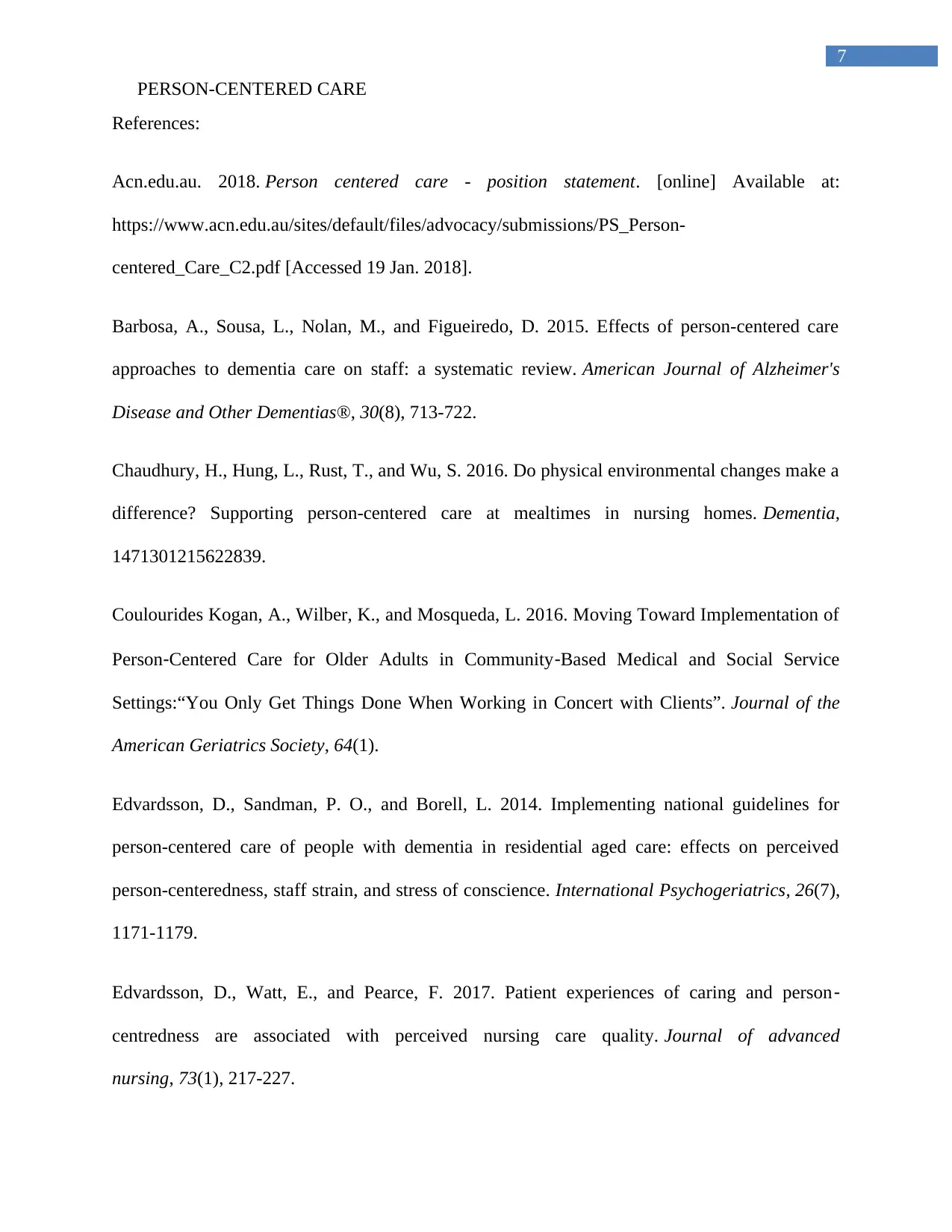
7
PERSON-CENTERED CARE
References:
Acn.edu.au. 2018. Person centered care - position statement. [online] Available at:
https://www.acn.edu.au/sites/default/files/advocacy/submissions/PS_Person-
centered_Care_C2.pdf [Accessed 19 Jan. 2018].
Barbosa, A., Sousa, L., Nolan, M., and Figueiredo, D. 2015. Effects of person-centered care
approaches to dementia care on staff: a systematic review. American Journal of Alzheimer's
Disease and Other Dementias®, 30(8), 713-722.
Chaudhury, H., Hung, L., Rust, T., and Wu, S. 2016. Do physical environmental changes make a
difference? Supporting person-centered care at mealtimes in nursing homes. Dementia,
1471301215622839.
Coulourides Kogan, A., Wilber, K., and Mosqueda, L. 2016. Moving Toward Implementation of
Person‐Centered Care for Older Adults in Community‐Based Medical and Social Service
Settings:“You Only Get Things Done When Working in Concert with Clients”. Journal of the
American Geriatrics Society, 64(1).
Edvardsson, D., Sandman, P. O., and Borell, L. 2014. Implementing national guidelines for
person-centered care of people with dementia in residential aged care: effects on perceived
person-centeredness, staff strain, and stress of conscience. International Psychogeriatrics, 26(7),
1171-1179.
Edvardsson, D., Watt, E., and Pearce, F. 2017. Patient experiences of caring and person‐
centredness are associated with perceived nursing care quality. Journal of advanced
nursing, 73(1), 217-227.
PERSON-CENTERED CARE
References:
Acn.edu.au. 2018. Person centered care - position statement. [online] Available at:
https://www.acn.edu.au/sites/default/files/advocacy/submissions/PS_Person-
centered_Care_C2.pdf [Accessed 19 Jan. 2018].
Barbosa, A., Sousa, L., Nolan, M., and Figueiredo, D. 2015. Effects of person-centered care
approaches to dementia care on staff: a systematic review. American Journal of Alzheimer's
Disease and Other Dementias®, 30(8), 713-722.
Chaudhury, H., Hung, L., Rust, T., and Wu, S. 2016. Do physical environmental changes make a
difference? Supporting person-centered care at mealtimes in nursing homes. Dementia,
1471301215622839.
Coulourides Kogan, A., Wilber, K., and Mosqueda, L. 2016. Moving Toward Implementation of
Person‐Centered Care for Older Adults in Community‐Based Medical and Social Service
Settings:“You Only Get Things Done When Working in Concert with Clients”. Journal of the
American Geriatrics Society, 64(1).
Edvardsson, D., Sandman, P. O., and Borell, L. 2014. Implementing national guidelines for
person-centered care of people with dementia in residential aged care: effects on perceived
person-centeredness, staff strain, and stress of conscience. International Psychogeriatrics, 26(7),
1171-1179.
Edvardsson, D., Watt, E., and Pearce, F. 2017. Patient experiences of caring and person‐
centredness are associated with perceived nursing care quality. Journal of advanced
nursing, 73(1), 217-227.
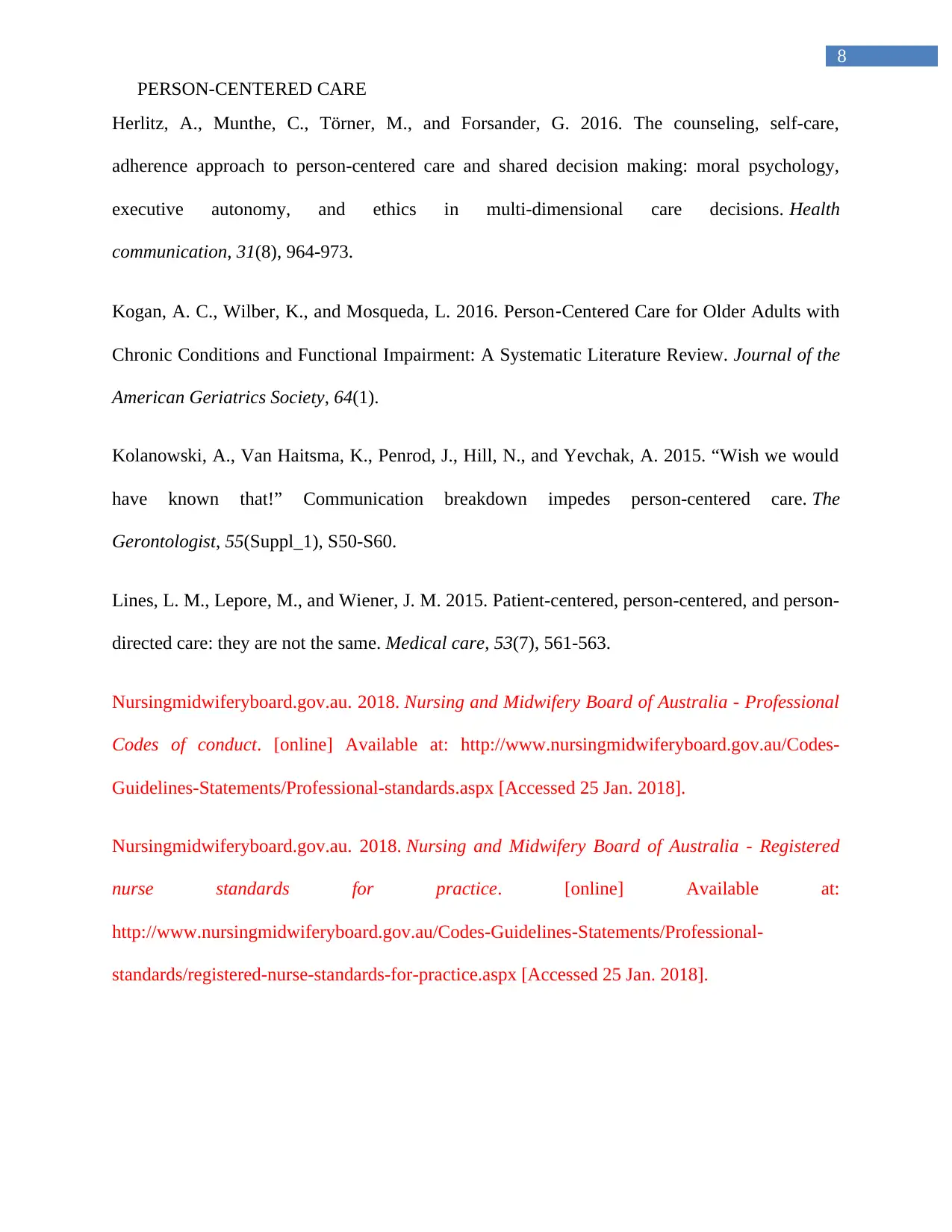
8
PERSON-CENTERED CARE
Herlitz, A., Munthe, C., Törner, M., and Forsander, G. 2016. The counseling, self-care,
adherence approach to person-centered care and shared decision making: moral psychology,
executive autonomy, and ethics in multi-dimensional care decisions. Health
communication, 31(8), 964-973.
Kogan, A. C., Wilber, K., and Mosqueda, L. 2016. Person‐Centered Care for Older Adults with
Chronic Conditions and Functional Impairment: A Systematic Literature Review. Journal of the
American Geriatrics Society, 64(1).
Kolanowski, A., Van Haitsma, K., Penrod, J., Hill, N., and Yevchak, A. 2015. “Wish we would
have known that!” Communication breakdown impedes person-centered care. The
Gerontologist, 55(Suppl_1), S50-S60.
Lines, L. M., Lepore, M., and Wiener, J. M. 2015. Patient-centered, person-centered, and person-
directed care: they are not the same. Medical care, 53(7), 561-563.
Nursingmidwiferyboard.gov.au. 2018. Nursing and Midwifery Board of Australia - Professional
Codes of conduct. [online] Available at: http://www.nursingmidwiferyboard.gov.au/Codes-
Guidelines-Statements/Professional-standards.aspx [Accessed 25 Jan. 2018].
Nursingmidwiferyboard.gov.au. 2018. Nursing and Midwifery Board of Australia - Registered
nurse standards for practice. [online] Available at:
http://www.nursingmidwiferyboard.gov.au/Codes-Guidelines-Statements/Professional-
standards/registered-nurse-standards-for-practice.aspx [Accessed 25 Jan. 2018].
PERSON-CENTERED CARE
Herlitz, A., Munthe, C., Törner, M., and Forsander, G. 2016. The counseling, self-care,
adherence approach to person-centered care and shared decision making: moral psychology,
executive autonomy, and ethics in multi-dimensional care decisions. Health
communication, 31(8), 964-973.
Kogan, A. C., Wilber, K., and Mosqueda, L. 2016. Person‐Centered Care for Older Adults with
Chronic Conditions and Functional Impairment: A Systematic Literature Review. Journal of the
American Geriatrics Society, 64(1).
Kolanowski, A., Van Haitsma, K., Penrod, J., Hill, N., and Yevchak, A. 2015. “Wish we would
have known that!” Communication breakdown impedes person-centered care. The
Gerontologist, 55(Suppl_1), S50-S60.
Lines, L. M., Lepore, M., and Wiener, J. M. 2015. Patient-centered, person-centered, and person-
directed care: they are not the same. Medical care, 53(7), 561-563.
Nursingmidwiferyboard.gov.au. 2018. Nursing and Midwifery Board of Australia - Professional
Codes of conduct. [online] Available at: http://www.nursingmidwiferyboard.gov.au/Codes-
Guidelines-Statements/Professional-standards.aspx [Accessed 25 Jan. 2018].
Nursingmidwiferyboard.gov.au. 2018. Nursing and Midwifery Board of Australia - Registered
nurse standards for practice. [online] Available at:
http://www.nursingmidwiferyboard.gov.au/Codes-Guidelines-Statements/Professional-
standards/registered-nurse-standards-for-practice.aspx [Accessed 25 Jan. 2018].
⊘ This is a preview!⊘
Do you want full access?
Subscribe today to unlock all pages.

Trusted by 1+ million students worldwide
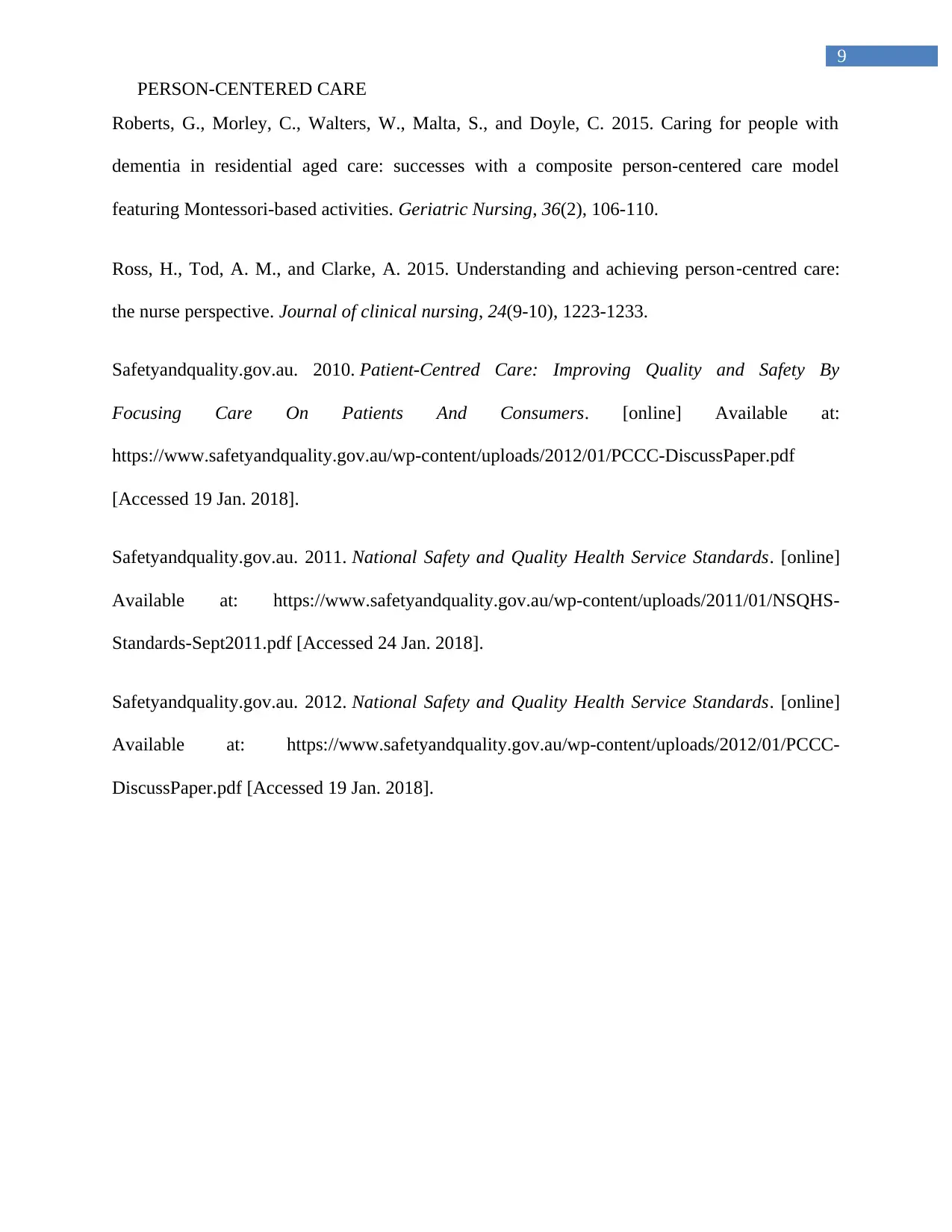
9
PERSON-CENTERED CARE
Roberts, G., Morley, C., Walters, W., Malta, S., and Doyle, C. 2015. Caring for people with
dementia in residential aged care: successes with a composite person-centered care model
featuring Montessori-based activities. Geriatric Nursing, 36(2), 106-110.
Ross, H., Tod, A. M., and Clarke, A. 2015. Understanding and achieving person‐centred care:
the nurse perspective. Journal of clinical nursing, 24(9-10), 1223-1233.
Safetyandquality.gov.au. 2010. Patient-Centred Care: Improving Quality and Safety By
Focusing Care On Patients And Consumers. [online] Available at:
https://www.safetyandquality.gov.au/wp-content/uploads/2012/01/PCCC-DiscussPaper.pdf
[Accessed 19 Jan. 2018].
Safetyandquality.gov.au. 2011. National Safety and Quality Health Service Standards. [online]
Available at: https://www.safetyandquality.gov.au/wp-content/uploads/2011/01/NSQHS-
Standards-Sept2011.pdf [Accessed 24 Jan. 2018].
Safetyandquality.gov.au. 2012. National Safety and Quality Health Service Standards. [online]
Available at: https://www.safetyandquality.gov.au/wp-content/uploads/2012/01/PCCC-
DiscussPaper.pdf [Accessed 19 Jan. 2018].
PERSON-CENTERED CARE
Roberts, G., Morley, C., Walters, W., Malta, S., and Doyle, C. 2015. Caring for people with
dementia in residential aged care: successes with a composite person-centered care model
featuring Montessori-based activities. Geriatric Nursing, 36(2), 106-110.
Ross, H., Tod, A. M., and Clarke, A. 2015. Understanding and achieving person‐centred care:
the nurse perspective. Journal of clinical nursing, 24(9-10), 1223-1233.
Safetyandquality.gov.au. 2010. Patient-Centred Care: Improving Quality and Safety By
Focusing Care On Patients And Consumers. [online] Available at:
https://www.safetyandquality.gov.au/wp-content/uploads/2012/01/PCCC-DiscussPaper.pdf
[Accessed 19 Jan. 2018].
Safetyandquality.gov.au. 2011. National Safety and Quality Health Service Standards. [online]
Available at: https://www.safetyandquality.gov.au/wp-content/uploads/2011/01/NSQHS-
Standards-Sept2011.pdf [Accessed 24 Jan. 2018].
Safetyandquality.gov.au. 2012. National Safety and Quality Health Service Standards. [online]
Available at: https://www.safetyandquality.gov.au/wp-content/uploads/2012/01/PCCC-
DiscussPaper.pdf [Accessed 19 Jan. 2018].
1 out of 10
Related Documents
Your All-in-One AI-Powered Toolkit for Academic Success.
+13062052269
info@desklib.com
Available 24*7 on WhatsApp / Email
![[object Object]](/_next/static/media/star-bottom.7253800d.svg)
Unlock your academic potential
Copyright © 2020–2025 A2Z Services. All Rights Reserved. Developed and managed by ZUCOL.





